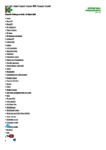Por favor, use este identificador para citar o enlazar este ítem:
http://www.alice.cnptia.embrapa.br/alice/handle/doc/339722| Título: | Mapping spatial and temporal potassium balances in Brazilian soils of south-west Goias. |
| Autor: | NAUMOV, A.  PRADO, R. B.   |
| Afiliación: | A. NAUMOV, International Potash Institute RACHEL BARDY PRADO, CNPS. |
| Año: | 2008 |
| Referencia: | E-ifc: International Fertilizer Correspondent, Horgen, n. 15, Mar. 2008. |
| Descripción: | Introduction: Brazil, is one of the main agricultural producers in the world ranking 1st in the production of sugarcane, coffee and oranges. It is also 2nd as world producer of soybeans and a leader in the harvested yields of many other crops. The annual consumption of mineral fertilizers exceeds 20 million mt, 30% of which corresponds to potash fertilizers (ANDA, 2006). From this statistic it may be supposed that fertilizer application in Brazil is rather high, compared with many other countries. However, even if it is assumed that only one fourth of this enormous 8.5 million km2 territory is used for agriculture, average levels of fertilizer application per hectare of arable land are not high enough for sustainable production. One of the major constraints is the relatively low natural fertility status of the soils which contain excessive Fe and Al oxides. Agriculture is also often practised on sandy soils so that the heavy rainfall causes large losses of nutrients through leaching. In general, nutrient removal by crops such as sugarcane and tropical fruits is much more than the average nutrient application via fertilization, especially in regions with a long history of agricultural production. In the recently developed areas, especially in the Cerrado (Brazilian savanna) where agriculture has expanded since 1980, soils are even poorer than in the "old" agricultural regions, and high costs of mineral fertilizers have become a significant input factor in determining soybean, maize and cotton planting. The consumption of mineral fertilizers throughout Brazil is very uneven. According to the 1995/96 Agricultural Census, only in eight of the total of 26 Brazilian states, were 50 per cent or more of the farms treated "systematically" with mineral fertilizers; in many states it was less than 25 per cent, and in five states even less than 12 per cent (Brazilian Institute for Geography and Statistics; Censo Agropecuario1995/96, Instituto Brazileiro de Geografia e Estadistica; IBGE, www.ibge.gov.br). The geographical application distribution pattern of mineral fertilizers may be considered as an important field of research. Understanding geographical disparities in fertilization level requires a complex approach. This includes evaluation of the availability of nutrients in the soil (and related soil properties e.g. CEC and texture), the input of nutrients with fertilizer application, and the removal of nutrients by harvested yields. When all these data are compiled, it is possible to evaluate the balance of particular nutrients for certain areas, and make conclusions as to where agricultural practices should be optimized. This kind of research is somewhat complicated, because it relies on completely different sources of data, usually from incomparable data sources, e.g. soil characteristics attributed to soil type areas, in contrast to yields by administrative regions, or farms. A priority tool in this case is the Geographical Information System (GIS), which enables attribution of data from different fields to the same territorial units, and makes possible integration of these data in an "inputoutput" model, where "input" is the natural availability of a nutrient in the soil plus fertilization, and "output" export of the same nutrient with the removed harvested yield. |
| Thesagro: | Potássio |
| Palabras clave: | Mapeamento Solos |
| Tipo de Material: | Artigo de periódico |
| Acceso: | openAccess |
| Aparece en las colecciones: | Artigo em periódico indexado (CNPS)  |
Ficheros en este ítem:
| Fichero | Descripción | Tamaño | Formato | |
|---|---|---|---|---|
| eifc15ResearchFindingsMappingspatialandtemporalpotassi.pdf | 437,18 kB | Adobe PDF |  Visualizar/Abrir |









